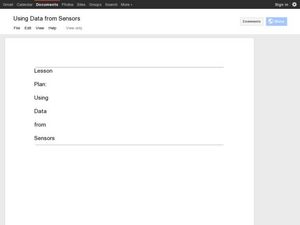Curated OER
Using Data from Sensors
Beginning with a discussion about using technology to collect data, this resource includes a video about the next Mars rover as an example. Young scientists are taught that filtering is necessary before collected data can be analyzed....
Curated OER
An Introduction to Sensors
Pupils list as many examples as they can of sensors in their homes and/or automobiles, define sensor and discuss what qualifies devices as sensors, explore human eyes as sensors while watching teacher demonstration, recognize that sensor...
Curated OER
Robots Alive: Almost Human
Students explore robotics. They design and draw a robot to fit a specified function. Students examine motor functions necessary for the robot to perform. They discuss types of sensors available to assist in the building of a robot.
Curated OER
Select a Sound: RCX Programming
Students program an RCX to play one sound if a touch sensor is pressed down and another if it is not pressed. They write the program to repeat twenty times and incorporate the use of both a fork and a loop.
TeachEngineering
Teach Engineering: Using Waits, Loops and Switches
Students incorporate their knowledge of wait blocks, loops, and switches into their programming of the LEGO MINDSTORMS NXT robots to perform different tasks depending on input from a sound sensor and two touch sensors. This activity...
TeachEngineering
Teach Engineering: How Do You Make Loops and Switches?
Students learn how to program using loops and switches. Using the LEGO MINDSTORMS NXT robots, sensors and software, student pairs perform three mini programming activities using loops and switches individually, and then combined.
TeachEngineering
Teach Engineering: Are We Like Robots?
Students explore the similarities between how humans move and walk and how robots move, so they come to see the human body as a system from an engineering point-of-view. Movement results from decision making (deciding to walk and move)...
TryEngineering
Try Engineering: Making Sense of Sensors
Lesson explore sensors focusing on ones that measure humidity. Students work in teams to design, build, test, and evaluate a hygrometer which was made out of everyday materials to measure humidity levels.
TryEngineering
Try Engineering: Temperature Tactics
Learners practice the engineering design process as they explore devices used to measure changes in temperature. They work in teams to design, build, test, and evaluate their own temperature gauge made from everyday materials.
Read Works
Read Works: Coral Reef Goes Digital
[Free Registration/Login Required] This informational text passage shares facts about This passage is a stand-alone curricular piece that reinforces essential reading skills and strategies and establishes scaffolding for vocabulary...
Treehut
Suzy's World: Touch
At this site find out how you can feel hot and cold and try this experiment using your sensory nerves.










